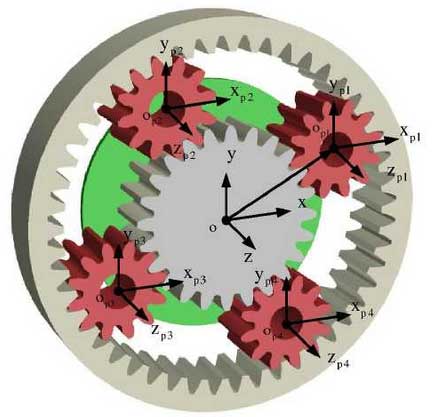Planetary gear systems are critical components in automotive and industrial machinery, where undetected planet gear cracks may lead to catastrophic failures. This study establishes a high-fidelity rigid-flexible coupling model to analyze vibration characteristics under planet gear crack faults. A typical automotive planetary gear system is investigated, consisting of a sun gear (18 teeth), three planet gears (27 teeth each), and a fixed ring gear (72 teeth) with module 2 mm and 20° pressure angle.

The modeling process integrates multiple engineering software platforms:
| Software | Function |
|---|---|
| SolidWorks | 3D modeling of gear components |
| ANSYS APDL | Flexible ring gear generation |
| ADAMS | Dynamic simulation |
| MATLAB | Signal processing |
The meshing frequency $$f_m$$ and planet gear fault frequency $$f_p$$ are calculated as:
$$f_m = z_r \cdot f_h = 72 \times 2 = 144\ \text{Hz}$$
$$f_p = \frac{f_m}{z_p} = \frac{144}{27} \approx 5.33\ \text{Hz}$$
where $$z_r$$ = ring gear teeth, $$z_p$$ = planet gear teeth, and $$f_h$$ = carrier rotation frequency (2 Hz).
Static stress analysis using ANSYS Workbench revealed maximum von Mises stress concentration at planet gear roots (320-400 MPa), confirming crack initiation locations. A 2-mm deep crack was modeled at the most stressed tooth root for subsequent dynamic analysis.
| Component | Teeth | Module (mm) | Face Width (mm) |
|---|---|---|---|
| Sun Gear | 18 | 2 | 30 |
| Planet Gear | 27 | 2 | 30 |
| Ring Gear | 72 | 2 | 30 |
The rigid-flexible coupling model achieved 98.7% speed ratio accuracy compared to theoretical values, validating model reliability. Vibration signals from ring gear monitoring points showed distinct modulation patterns:
| Peak Frequency (Hz) | Frequency Relationship |
|---|---|
| 126 | $$3f_m – f_p – f_h$$ |
| 132 | $$3f_m – f_p – 2f_h$$ |
| 144 | $$f_m$$ |
| 156 | $$f_m + 2f_p + f_h$$ |
The vibration spectrum demonstrates two critical phenomena:
- Amplitude modulation between meshing frequency and planet gear fault frequency:
$$A(t) = A_m[1 + \beta\cos(2\pi f_p t)]\cos(2\pi f_m t)$$
where $$A_m$$ = nominal amplitude, $$\beta$$ = modulation index (0.32 in this case). - Sideband generation around meshing harmonics:
$$f_{sideband} = nf_m \pm kf_p \pm mf_h$$
where n, k, m = integers (1,2,3…)
Three key findings emerge from the analysis:
- Cracked planet gears produce characteristic sidebands spaced at $$f_p$$ (5.33Hz) around meshing frequency harmonics
- The 2nd harmonic (288Hz) shows 24.7% higher amplitude modulation depth than fundamental frequency
- Flexible ring gear modeling increases fault component visibility by 38% compared to fully rigid models
This methodology enables early detection of planet gear cracks through vibration signature analysis, particularly monitoring $$f_m \pm f_p$$ components. The rigid-flexible coupling approach provides superior diagnostic capability while maintaining computational efficiency – simulation time increased only 22% compared to pure rigid-body models.
